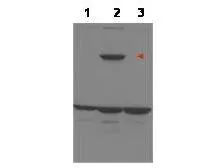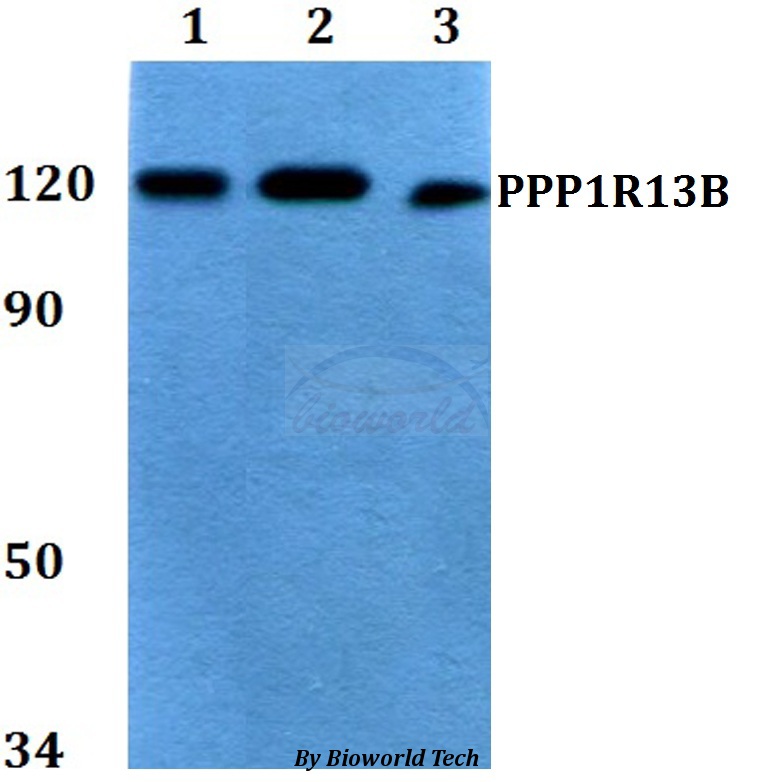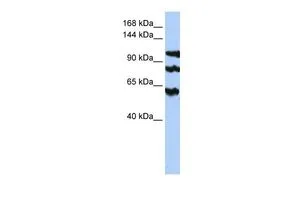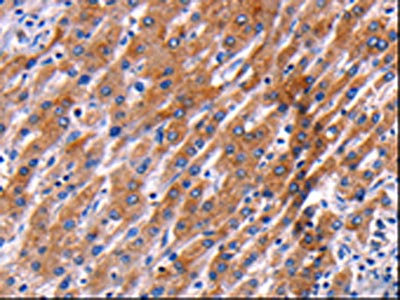
Western blot using GeneTexs affinity purified anti-ASPP1 to detect over-expressed ASPP1 in MCF-7 cells (lane 2, arrowhead). Lane 1 is a non-transfected control. Lane 3 is MCF-7 cells over-expressing ASPP2. Cell extracts were electrophoresed and transferred to nitrocellulose. The membrane was probed with the primary antibody at a 1:1,000 dilution. The identity of the lower MW band at approximately 50kDa is unknown. Primary experimental data indicate that the unknown band intensifies in extracts from p53 siRNA knockdown cells.
ASPP1 antibody
GTX48719
ApplicationsWestern Blot, ELISA
Product group Antibodies
TargetPPP1R13B
Overview
- SupplierGeneTex
- Product NameASPP1 antibody
- Delivery Days Customer9
- Application Supplier NoteWB: 1:500-1:3000. ELISA: 1:2500-1:10000. *Optimal dilutions/concentrations should be determined by the researcher.Not tested in other applications.
- ApplicationsWestern Blot, ELISA
- CertificationResearch Use Only
- ClonalityPolyclonal
- Concentration0.33 mg/ml
- ConjugateUnconjugated
- Gene ID23368
- Target namePPP1R13B
- Target descriptionprotein phosphatase 1 regulatory subunit 13B
- Target synonymsASPP1, p53BP2-like, p85, apoptosis-stimulating of p53 protein 1, apoptosis-stimulating protein of p53, 1, protein phosphatase 1, regulatory (inhibitor) subunit 13B
- HostRabbit
- IsotypeIgG
- Protein IDQ96KQ4
- Protein NameApoptosis-stimulating of p53 protein 1
- Scientific DescriptionASPP (ankyrin-repeat-, SH3-domain- proline-rich-region protein) proteins (ASPP1, ASPP2 and iASPP) represent a new family of p53 binding proteins. ASPP1 and ASPP2 bind and enhance p53-mediated apoptosis. In contrast, iASPP functionally inactivates p53. ASPPs may also regulate p63- and p73-mediated apoptosis. Both ASPP1 and 2 directly interact with p53 and specifically enhance the apoptotic function of p53 by stimulating its DNA binding and transactivation function on promoters of pro-apoptotic genes, such as Bax and PIG-3. Not all cell cycle arrest genes are affected, such as p21. Interestingly, expression of ASPP is frequently down-regulated in human breast carcinomas expressing wild-type p53 but not mutant p53. Therefore, ASPP might regulate the tumor suppression function of p53 in vivo.
- Storage Instruction-20°C or -80°C,2°C to 8°C
- UNSPSC12352203







